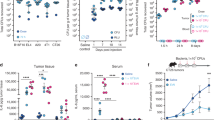Abstract
Bacterial superantigens (SAGs) bind to cognate Vβ elements of T-cell receptors on T-cells and to major histocompatibility complex (MHC) class II molecules on antigen-presenting cells to activate T-cell subsets expressing the Vβ elements. We examined the possibility that the direct binding of SAGs (staphylococcal enterotoxins B [SEB] and A [SEA]) to tumor cells decreases the toxicity of SAGs, and that antitumor immunity can be induced with the aid of T-helper-1 (Th1)-type cytokines and monokines released from T-cells and monocytes, respectively, by activation with SAGs. In this context, we have developed a general method for conjugating SEB and SEA directly to tumor cells with a heterobifunctional cross linking agent, N-(γ-maleimidobutyryloxy) sulfosuccinimide sodium salt. Using this method, we have succeeded in conjugating SEB to a sufficient extent as to induce strong tumor immunity. Both in vitro T-cell culture with SEB-bearing Meth A cells and in vivo immunization with SEB-bearing Meth A cells induce strong antitumor activity. These results suggest that the direct conjugation of SAGs including SEB and SEA to tumor cells is a powerful and useful method for immunotherapy of cancer.
Similar content being viewed by others
References
Marrack, P. and Kappler, J. (1990) The staphylococcal enterotoxins and their relatives. Science 248, 705–711.
Herman, A., Kappler, J. W., Marrack, P., and Pullen, A. M. (1991) Superantigens: mechanism of T-cell stimulation and role in immune responses. Annu. Rev. Immunol. 9, 745–772.
White, J., Herman, A., Pullen, A. M., et al. (1989) The Vβ-specific superantigen staphylococcal enterotoxin B: stimulation of mature T-cells and clonal deletion in neonatal mice. Cell 56, 27–35.
Fraser, J. D. (1989) High-affinity binding of staphylococcal enterotoxin A and B to HLA-DR. Nature 339, 221–223.
Peavy, D. L., Adler, W. H., and Smith, R. T. (1970) The mitogenic effects of endotoxin and staphylococcal enterotoxin B on mouse spleen cells and human peripheral lymphocytes. J. Immunol. 105, 1453–1458.
Carlsson, R. and Sjögren, H. O. (1985) Kinetics of IL-2 and interferon-γ production, expression of IL-2 receptors, and cell proliferation in human mononuclear cells exposed to staphylococcal enterotoxin A. Cell. Immunol. 96, 175–183.
Fischer, H., Dohlsten, M., Andersson, U., et al. (1990) Production of TNF-α and TNF-β by staphylococcal enterotoxin A activated human T-cells. J. Immunol. 144, 4663–4469.
Shimizu, M., Yamamoto, A., Nakano, H., and Matsuzawa, A. (1996) Augmentation of antitumor immunity with bacterial superantigen, staphylococcal enterotoxin B-bound tumor cells. Cancer Res. 56, 3731–3736.
Spero, L., Stefanye, D., Brecher, P. I., et al. (1965) Amino acid composition and terminal amino acids of staphylococcal enterotoxin B. Biochemistry 4, 1024–1030.
Huang, I-Y. and Bergdoll. M. S. (1970) The primary structure of staphylococcal enterotoxin B. III. The cyanogen bromide peptides of reduced and aminoethylated enterotoxin B, and the complete amino acid sequence. J. Biol. Chem. 245, 3518–3525.
Mehrishi, J. N. and Grassetti, D. R. (1969) Sulphydryl groups on the surface of intact Ehrlich ascites tumour cells, human blood platelets and lymphocytes. Nature 224, 563–564.
Acha-Orbea, H. and Palmer, E. (1991) Mls-a retrovirus exploits the immune system. Immunol. Today 12, 356–361.
Author information
Authors and Affiliations
Corresponding author
Rights and permissions
About this article
Cite this article
Shimizu, M., Matsuzawa, A. & Takeda, Y. A novel method for modification of tumor cells with bacterial superantigen with a heterobifunctional cross-linking agent in immunotherapy of cancer. Mol Biotechnol 25, 89–94 (2003). https://doi.org/10.1385/MB:25:1:89
Issue Date:
DOI: https://doi.org/10.1385/MB:25:1:89




